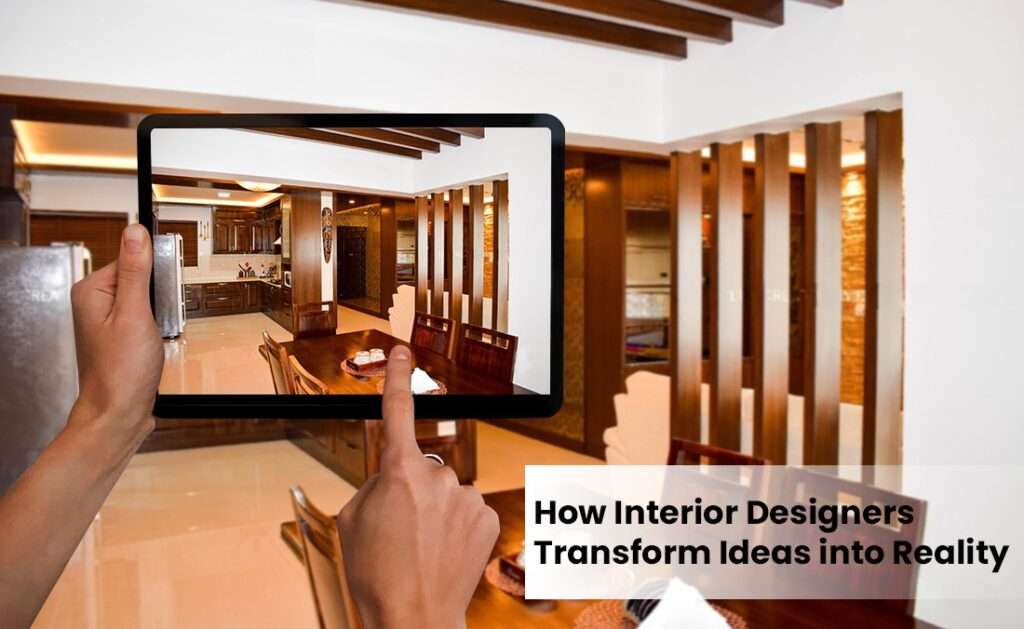How an Interior Designer Transforms Ideas into Reality

Interior design is a compelling blend of beauty and functionality that brings spaces to life with its own personality and character. Many people have a strong picture of what they want for their homes, including the colours, textures, and general aesthetic. However, turning these concepts into a unified and harmonious design can be a challenging undertaking. Here is when an interior designer’s knowledge comes in handy.
Understanding the Client’s Vision and Lifestyle Needs
The transformation process starts with a deep dive into the client’s world. Before drafting plans or selecting colors, the designer must understand the client’s lifestyle, habits, and space goals, sometimes even the client’s equation with their family members. Everyone has an inherent aesthetic shaped by their experiences, culture, and environment. The designer’s role is to uncover and visually express this style.
A well-designed home isn’t just beautiful; it’s functional. A family with children needs durable materials and smart storage, while frequent entertainers need seamless layouts. Through conversations, inspiration boards, and mood-setting, the designer captures the space’s intended look, feel, and purpose.
Space Planning and Layout Design:-
Once the core idea of the client’s vision is clear, the next step is to translate that vision into a physical structure. Space planning is perhaps one of the most important steps of design, as it is when raw ideas begin to take shape. Every square inch counts, and designers must carefully consider how to mix aesthetics with utility.
Effective space planning isn’t just about where furniture goes; it is also about establishing a harmonious flow that encourages movement and usability. It is about maximising the potential of a space, no matter its size or configuration. Interior designers are masters of visualizing in three dimensions — understanding how light, perspective, and spatial relationships work together to either expand or constrain a room.
Through the use of scaled drawings, 3D renderings, and meticulous measurements, designers craft layouts that anticipate how people will live, move, and feel within a space. This thoughtful approach ensures that every corner, hallway, and transition serves a purpose while adhering to the client’s aesthetic.
Material and Color Selection:-
Choosing the right materials and color schemes is not simply about matching tones; it’s about evoking emotion and the right energy within the room. Interior designers have a deep understanding of the psychological and sensory effects of materials and hues — knowing, for instance, that natural wood might evoke warmth and grounding, while sleek marble introduces elegance and sophistication.
Designers also consider texture, pattern, and finish in their selections, carefully curating how various materials interact under light and touch. Will the client prefer the cool smoothness of ceramic tiles or the plush embrace of a velvet sofa? Is the room bathed in natural light, or does it rely heavily on artificial sources? These subtle nuances, expertly orchestrated, elevate a design from good to exceptional.
Furniture and Décor:-
The furniture and décor within a room serve as the final expression of the client’s personality. A designer’s task here is to marry form with function, selecting pieces that not only look stunning but are aligned with the practicalities of daily life. Every chair, table, and accent piece must be curated with an understanding of how the client will interact with it.
The designer’s role here is to balance these elements so that they enhance rather than overwhelm a space, guiding the client toward selections that resonate on a deeper level.
Lighting Design in Home Décor:-
Creating an interior design project without a lighting designer is like attending a concert and only listening to the soundtrack without any assembly of voices, tones and instruments. The music might be fine, but the full performance is where the magic happens. Expertly placed lighting adds a whole new dimension to a space, bringing an interior design project to life. Great lighting generates depth and height, comfortable nooks, and highlights the most outstanding features of your home.
The Importance of Lighting Effect in Interior Design, frequently underestimated but necessary for creating useful, beautiful, and comfortable rooms. It goes beyond simple illumination, altering the atmosphere, improving mood, and even influencing behaviour. Understanding and properly utilising lighting may convert a dull environment into a refuge of warmth, productivity, and aesthetics.
The Impact of a Professional Designer on Bringing Ideas to Life
A professional designer possesses the ability to foresee potential obstacles and offer creative solutions before problems even arise. They ensure that the design not only looks stunning but works seamlessly with the realities of everyday life. Through their experience, they bring a depth of knowledge about materials, craftsmanship, and space that the average person might not consider. This foresight, combined with an artistic sensibility is what turns a vision into reality, often surpassing the client’s expectations.
Ultimately, the impact of a professional designer is felt long after the final touches are made. It’s in the way the home functions effortlessly for its inhabitants, how it evokes emotion every time they walk through the door, and how it becomes a true reflection of their life, captured in physical form. The Creative Axis has the experience to build a beautiful, practical house where Comfort, Luxury and lifestyle are blend into your everyday living at the same time. Contact us today to begin creating your perfect living space, your comfort zone, your dream home.
